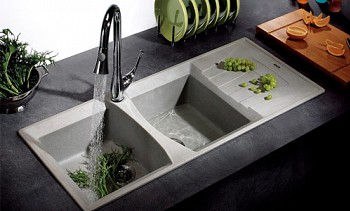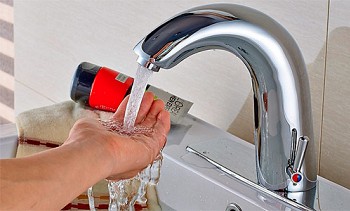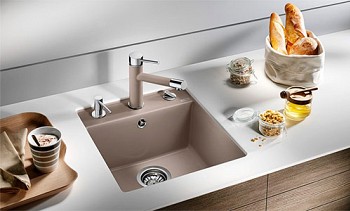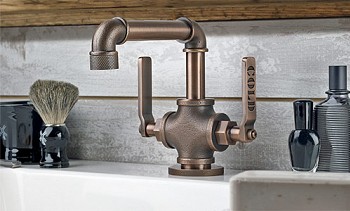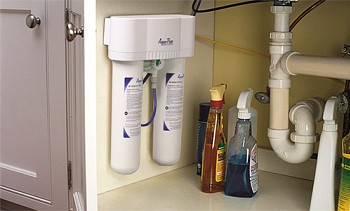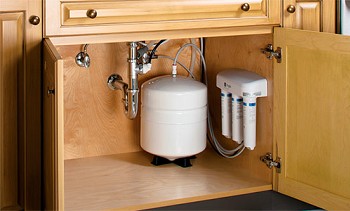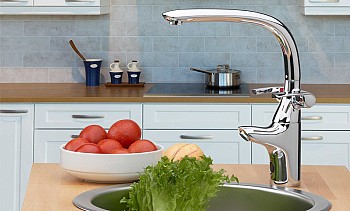There are no secondary things in the kitchen. If you intend to make the kitchen truly functional, you should carefully consider all the subtleties of this room. This applies not only to the color of facades and the number of cabinets, but also to seemingly prosaic things such as work desks and sinks. Designers have come up with many types of sinks for the kitchen, each of which is very popular. We offer you to get acquainted with practical tips for choosing a sink for the kitchen.
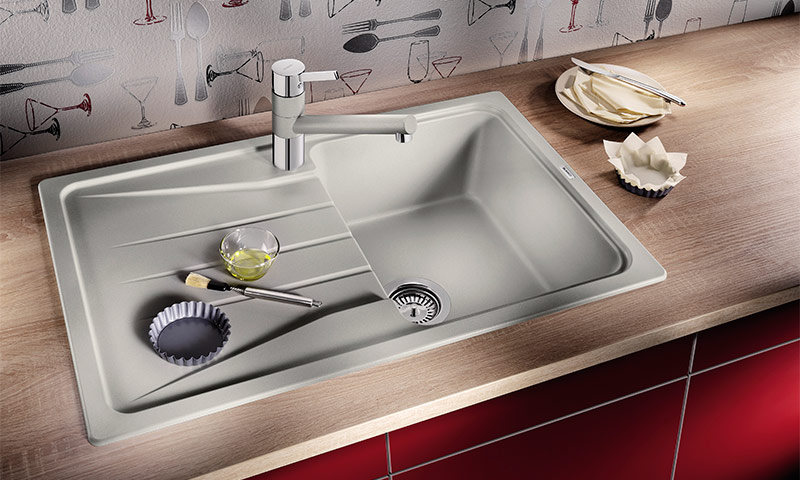
Content:
Choose the type of installation of the sink
Washing dishes is an inevitable process that you will do every day, or even several times a day. Not only the quality of the result, but also your mood and the condition of the furniture near you depends on the convenience of the sink. Spray is an indispensable concomitant of washing plates, spoons and mugs. There are several requirements to the design of the sink, following which you can choose the best option. The sink should be: spacious; convenient in work; organically fit into the design of the kitchen; Do not make loud noises when using.
Overhead
When choosing a sink, you should focus on the type of furniture selected for the kitchen. If you have a standard kitchen set, then there should be a place for a sink - a table with special mountings. It is recommended to calculate its location even at the stage of creating the design project - the module with the sink should be located in a convenient place, at some distance from the side wall, so that there is no interference with the work.
Naturally, the water supply should also be designed to connect to this type of equipment. In most cases, a hole is made for the mixer in the sink; when assembled, they represent one design.

Laid on steel sink.
But the features of the overhead bowl allow the use of wall-mounted faucets. This is somewhat less common, but, undoubtedly, has the right to life - this type of installation significantly saves space and makes the workspace more convenient.
An indispensable attribute of the surface sink is a side that protrudes above the countertop and protects adjacent surfaces and the wall from splashes. Such sides can be of different heights and shapes, but they must be provided for sure. The joints of the sink with other modules of the equipment must be sealed to prevent water from flowing into the structures.
Mortise
Sinks installed in a special slot in the countertop. They can even be called traditional. Such designs are more common in a modern kitchen interior. Their distribution is facilitated by a large number of design and functional options, including the presence of one or more cups, wings, rear or side walls, additional work surfaces.
According to the installation method, mortise sinks can be divided into three large types:
- mounted on top;
- flush;
- below, under the countertop.
The first option is the most common and most convenient both during installation and during operation. It is also very beneficial in design - a variety of designs and materials used allows you to turn a purely functional element of the kitchen into a decorative one.
With the upper installation, it is enough to cut a hole in the countertop, the size corresponding to the contours of the bowl below the side. After installing the sink, the side (wide enough in this type of structure) enters the countertop and completely closes the joint.
When installing a mortise sink, it is necessary to seal the perimeter of the slot contour so that water accidentally falling outside the bowl does not flow into the cabinet. Such sinks, most often, are installed on wooden and MDF countertops, so waterproofing plays a big role. When mounting in stone or glass countertops, there are no such requirements for the level of sealing, but, nevertheless, it is necessary to isolate the space under the sink from the penetration of water - this will eliminate unpleasant odors and mold.

Mortise sink mounted on top.
Flush mounted sinks are also installed in all types of countertops, but more often in stone and glass. During installation, they require very high accuracy in the preparation of the mounting hole - the edge is very narrow, or it does not exist at all. If you are not sure about the level of your own skill, then it is better to use the services of a master.
If at the top installation of the sink the mixer can be installed both on the sink and on the countertop or wall, then when installing flush-mounted on the sink, the faucet cannot be installed. The choice depends on the configuration of the plumbing system and the mixer version. In both cases, it is convenient to use the mixer and replacing it does not cause problems, as does replacing the sink itself.

Flush mounted sink.
The biggest difficulties are installing the sink below, under the countertop. In this case, it is completely below the tabletop level, which imposes some restrictions on the use of this system - usually this option is used in the presence of a stone or glass tabletop. As in the previous case, the mixer is mounted on a wall or countertop.

A sink installed under the countertop.
Advise how to choose a sink for the kitchen, you can only see the full version of the design of the room and knowing exactly the configuration of the water supply network. As a rule, all decisions on the choice of washing must be taken during the preparation of the project. Upon purchase, it is necessary to check the presence of all fastening elements so that during installation there are no difficulties and delays.
Other installation methods
There are other options for installing sinks in the kitchen. There are many ways to furnish a kitchen and design its design, for which the sinks described above are completely unsuitable. It is more appropriate wall mount or installation on a freestanding table. This is especially true for cast iron sinks, which are available only for this installation option.
Kitchens decorated in folk style, hi-tech or modern, as well as now eclectic fashion, also allow the installation of sinks in unusual places and with rather non-standard fixtures. But in the pursuit of extravagance and original design, one should not forget that the sink is an exclusively functional element of the situation, and you should not sacrifice the ease of use even for the most sophisticated design.
How to determine the design of the sink
Manufacturers of plumbing and kitchen equipment offer different types of sinks and it may seem that determining which sink is better to choose for the kitchen is quite difficult. In fact, the design of the kitchen and personal preferences play a big role here, but besides this, it is necessary to take into account the practical aspects of using a sink, the possibility of a kitchen set and the kitchen room as a whole.
Number of sinks
By the number of bowls, sinks can be:
- with one bowl;
- with two bowls of the same size;
- with two bowls of different sizes;
- with three bowls.
In the classic form, the kitchen sink has one bowl, the immediate purpose of which is washing dishes.

The advantage of sinks with two bowls of the same size is their convenience and versatility. In this case, you will have two bowls, in one of which you can, for example, soak a burnt pot or pan, and in the second wash the dishes.

Sinks with two bowls, of different sizes, also expand the functionality of this kitchen appliance.For example, in a small bowl it is very convenient to wash and peel fruits or vegetables, while in a large bowl there will be dirty dishes.

There are also sinks with three bowls, two of which are the same in size, and the third is slightly smaller. But it is desirable to install such sinks in kitchens of a large area - they are rather bulky and not quite convenient to use.

An indispensable attribute of a sink is a drain. It is very good when it is equipped with a valve that allows you to draw a certain amount of water into the sink, for example, for soaking dishes. Some sinks are equipped with a drain and overflow, which is also quite convenient during operation. The presence of overflow is especially important if, when using the sink, you will often draw into its water.
Bowl shape
Sinks with various shapes of bowls are made:
Round.

Rectangular

Square.

Oval.

Trapezoidal.

Practice shows that it is best to use square sinks with two bowls of different sizes. But the corners in the bowls should be rounded along a noticeable radius - this allows you to eliminate the "dead" zones and make full use of the volume. Round bowls are also convenient, and with angular installation - triangular.
As with the choice of installation option, the shape of the bowl should be selected not only for aesthetic and design qualities, but, first of all, for functionality. If you have a one-room or a small two-room apartment, then washing with three tanks with round bowls is not worth buying, it is quite enough to double, or even a single, but always with a side platform.
Bowl depth
The depth of the sink is in the range of 120 - 200 mm, the usability and the amount of dishes that can be washed at a time depend on this parameter. In houses where large families live and often prepare food, sinks of great depth should be installed, at least 180 mm.
And in small apartments, where only a few plates or cups are washed at a time, 120 - 140 mm is enough.
If there is a drain with a valve, the washing depth also matters - the larger it is, the greater the amount of water for soaking dishes can be stocked up. But with a conventional drain, it is more convenient to wash with an average depth indicator. As in any, not only kitchen equipment, extreme indicators in the range of parameters are the least practical. The lowest ones lead to a decrease in usability and short-lived operation, and the maximum ones lead to an extra waste of money. Most of the functionality is never used. The criterion for selection should be reasonable minimalism.
Side around the bowl
Convenience and ergonomics of the sink also depend on the presence and shape of the sides. Almost every sink has larger or smaller sides. Often, they made ready-made holes for the mixer, or a place is outlined where it is most convenient to cut through them. If your water supply system is designed for the installation of a wall mixer, then you should buy a sink with a narrow side, a wide one will only interfere, and the hole will have to be plugged, which is ugly and leads to unnecessary expenses.
Several holes can be provided in the side, the purpose of which is not entirely clear. They can be intended for a mixer and a detergent dispenser, for two mixers (in large sinks for several bowls), for an additional drain. If you don’t understand the purpose of the additional holes, or if your water supply and sewerage are not suitable for them, choose another option.
Sinks with or without a wing
The total amount of time spent washing the dishes depends on which sink to choose for the kitchen. The workplace should be convenient and ergonomic, and the equipment for washing dishes with good reason can be called the workplace of a housewife (or a bachelor, as well as any cooking lover).
An important element of the sink is the wing - a horizontal plane on one or both sides of the sink, overlooking the working area of the kitchen set.In most cases, the wing is corrugated, with grooves guiding the flow of water. But there are models with smooth wings. When buying or installing them, it is necessary to check the inclination of the plane - it should be directed towards the sink so that the water does not stagnate and puddles do not form, which will constantly have to be wiped. There are models with absolutely no wings, or with very narrow platforms.
Before choosing a washing option, you need to decide on your culinary inclinations - if you are not going to cook a lot and often, then the wing may not be necessary, but only occupy a scarce place.
But in the case of a passion for cooking or the need to cook a lot and often, a spacious wing is simply necessary. The wing is very convenient for arranging various kitchen utensils, preparing vegetables or drying dishes.

Sink can be performed with the right or left wing. The choice will depend on your personal preferences and features of the kitchen.

Sinks designed for bottom mounting are usually not equipped with a wing. Its role is played by the surface of a glass or stone countertop. But it is desirable to install a wing on wooden or MDF structures - water falling on them will eventually render the material unusable.
Selection of sink material
Stainless steel
The main and most popular material for the manufacture of sinks is stainless steel. But steel became strife. Manufacturers use various brands, not all of them are suitable for continuous contact with water and detergents. Low-quality steel can be recognized only after the appearance of corrosion spots on the surface of the bowl or wing.
This phenomenon is quite rare, but it should be expected if you bought a sink from an unknown manufacturer at a completely dumped price. If you intend to buy a stainless steel sink, then pay attention to the brand. As a rule, well-known manufacturers do not save on metal.
If the steel grade from which the sink is made is indicated in the product’s passport or on the label, then its composition can be deciphered by the metal litter, opening any metallurgy website. High-quality steel should contain at least 18% chromium and 10% nickel, only in this case a long service life is guaranteed.
Before choosing a stainless steel kitchen sink in the final version, you need to pay attention to the thickness of the metal from which it is made. If a sheet with a thickness of less than 0.5 mm is used in the production, then you should not buy such a sink. In addition to the fact that it will rattle violently when a jet of water falls, damage by sharp edges of metal utensils or simply solid objects is inevitable.
Sink thickness in the range of 0.6 - 0.9 mm is optimal. Such products are acceptable in weight, have sufficient mechanical strength and are not too noisy. Their price is quite affordable. Such metal is used to wash all the most common structures. More expensive sinks are made of sheet up to 1.2 mm thick. They can be recognized by welds between structural elements. Seams are usually polished and sanded, but you can notice them. The presence of welds, paradoxically, is an indicator of high quality and durability of the sink.
The stainless steel surface is polished to a mirror state, matted or decorated with a PVD coating. Mirror surfaces are most beautiful, but also require careful handling - the slightest scratches become noticeable and it is quite difficult to eliminate them.

Matte sinks are the most practical - they are invisible spots, smudges and slight scratches. They are easy to wash - after household kitchen products no stains remain, even light solvents do not leave marks on the surface. When processing abrasive powders for stoves, the sink also retains its original appearance.

PVD surfaces are very decorative and quite durable.This method is applied to spraying a watch, the quality of the coatings of which is not in doubt and is durable under fairly severe operating conditions. But beauty requires sacrifice - made for gold, copper, bronze or artificially aged coating is quite expensive. But such sinks are designed for exclusive interiors, which are designed for significant financial costs.

Fake diamond
Sinks from this material have recently received significant distribution and are not inferior in popularity to stainless ones. Artificial stone is a mixture of natural raw materials with polymer binders. As a filler, marble or granite chips or quartz agglomerate are used. After solidification, the mixture is characterized by high strength, smooth surface and the ability to keep its shape under any mechanical and thermal influences.
An important argument in favor of choosing a sink made of artificial stone is a wide range of color solutions - you can choose either a complete imitation of natural minerals or completely original colors and textures that are not found in nature. Countertops are often made from polymer-mineral composites too. By choosing the sink and top of the table correctly, you can get very beautiful combinations that adorn the interior of the kitchen.
Stone sinks are almost silent, not subject to corrosion, are not afraid of detergents and organic solvents. Mechanical strength is also quite high, as well as temperature resistance.

There are several varieties of stone sinks. All of them are made from natural and synthetic materials, the properties of which to some extent resemble stone.
The most common materials for the production of stone sinks are:
- porcelain tile;
- acrylic stone;
- agglomerate.
Earlier we wrote about stone sinks of various types, where we compared their positive and negative sides, so we will not repeat here.
- You can read about comparing different stone sinks in the article:Advantages and disadvantages of stone kitchen sinks.
Ceramics
Ceramic sinks are also characterized by similar properties. They are less common, but also found in the collections of many manufacturers. By the number of color solutions, they are significantly inferior to artificial stone, they are also less durable, but heavier and more difficult to install. interiors.

Cast iron
With one sound of this word, there is a feeling of massiveness and reliability. These are the cast-iron sinks. They are made by casting and covered with a rather thick and durable layer of enamel in different colors. But mainly white and bluish products are in demand because of their attractive appearance and practicality. Some manufacturers of cast iron sinks, for example, the Kohler factory, rely on original forms - many models of sinks can be considered works of art.
Like cast iron bathtubs, sinks are characterized by high heat capacity, high weight and high requirements for fastening strength. Enamel is very sensitive to sudden changes in temperature, and blows by massive objects or the fall of metal tools or utensils can lead to cracks not only on the enamel, but also in the body of the product.
In most cases, cast iron sinks are designed for wall mounting, but there are mortise models. Enamel is not inferior to stainless steel in its simplicity of surface care, but is more sensitive to abrasives. So that the enamel does not lose its shine, it is better to wash it with soft sponges and a cloth, without using metal nets and brushes.

Sinks from other materials
In addition to stainless steel, artificial stone and cast iron, sinks can be made of other materials:
- glass;
- natural stone;
- copper;
- bronzes;
- polymers.
There are even wooden sinks. But usually all sinks made from non-standard materials are piece products made for a specific interior. They are expensive, in addition to functionality they have high decorative value and are not widely distributed.More often you can find combined sinks. They are made from several materials, for example, a stainless steel bowl and a glass wing, or a stainless or bronze wing on a stone bowl.
In most cases, combined sinks are much more practical than made from one material. Very often, their prices are not higher than the cost of conventional kitchen equipment and anyone can buy them.
We select additional accessories for washing
The washing set may also include additional equipment that significantly expands the functionality, for example, an integrated cutting board, a lattice dryer for dishes, fruits or vegetables, mounted on a bowl, a collander - a kind of colander with fastening on board the sink. Simple at first glance appliances can save up to 25% of the time when cooking various dishes and cleaning in the kitchen.

Sink with a sliding cutting board.

Collander for washing.

Drainer.
An important device that can be supplemented with a sink siphon is the disposer - a food waste shredder. The chopper turns pieces of waste from vegetables, fruits and other products into a homogeneous pulp, which is easily washed off with water. Practice shows that in the presence of a disposer, the need for cleaning sewer pipes arises an order of magnitude less often.

Sectional Disposer.
Each of the manufacturers of kitchen equipment offers its own options for sinks and accessories for them. When choosing, you should look not only at the level of design, but also at the practicality of use. The sink is always in demand, even if there is a powerful dishwasher in the kitchen.

